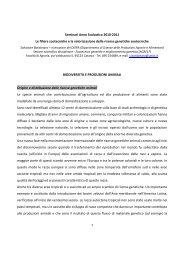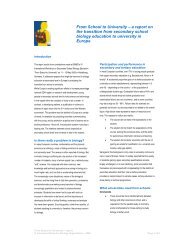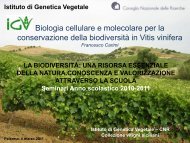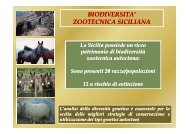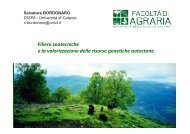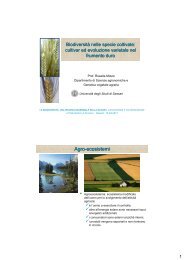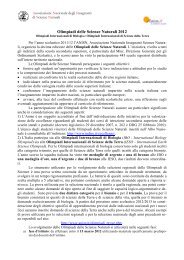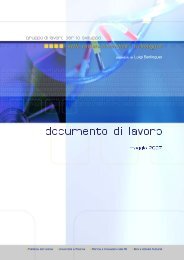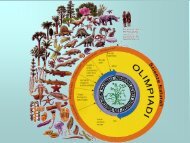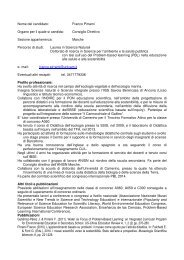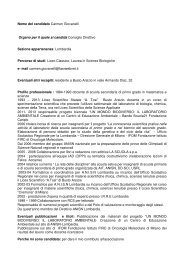Ricerche nella didattica e nella formazione degli <strong>in</strong>segnanti di <strong>scienze</strong>Méheut M. et Psillos D. (2004) Teach<strong>in</strong>g-learn<strong>in</strong>g sequences: aims and tools for science educationresearch. International Journal of Science Education, 26(5), 515-535.Millar, R. (1996) Investigation des élèves en sciences: une approche fondée sur la connaissance.Didaskalia, 9, 9-30.Millar, R. e Kanari, Z. (2003) How children reason from data to conclusions <strong>in</strong> practical science<strong>in</strong>vestigations? In D. Psillos, P. Kariotoglou, V. Tselfes, E. Hatzikraniotis, G. Fassoulopoulos e M. Kallery (Eds)Science Education Research <strong>in</strong> the Knowledge Based Society (Dordrecht: Kluwer) 117-126.M<strong>in</strong>istry of Education (1993) Science <strong>in</strong> the New Zealand Curriculum (Well<strong>in</strong>gton: Learn<strong>in</strong>g Media).Morge, L. (2001) Caractérisation des phases de conclusion dans l’enseignement scientifique. Didaskalia,18, 99-120.Morge, L. (2003a) Les connaissances profession<strong>nelle</strong>s locales: le cas d’une séance sur le modèleparticulaire. Didaskalia, 23, 101-132.Morge, L. (2003b) Mesure de l’impact d’une formation aux <strong>in</strong>teractions sur les pratiques enseignantes etles performances des élèves: aspects méthodologiques. In V. Albe, C. Orange e L. Simonneaux (Eds)Recherches en Didactique des Sciences et des Techniques: Questions en Débat, Actes des Troisièmes RencontresScientifiques de l’ARDIST (Toulouse: ENFA) 101-106.Mork, S.M. (2005) Argumentation <strong>in</strong> science lessons: Focus<strong>in</strong>g on the teacher’s role. Nordic Studies <strong>in</strong>Science Education,1, 17-30.Mortimer, E. e Scott, P. (2003) Mean<strong>in</strong>g mak<strong>in</strong>g <strong>in</strong> secondary science classrooms. (Maidenhead Philadelphia:Open University Press).National Research Council (1996) National Science Education Standards (Wash<strong>in</strong>gton: National AcademyPress).National Research Council (2000) Inquiry and the National Science Education Standards (Wash<strong>in</strong>gton:National Academy Press).Niedderer, H., Aufschnaiter, S., Tiberghien, A., Buty, C., Haller, K., Hucke, L., Sander, F. e Fischer, H. (2002)Talk<strong>in</strong>g physics <strong>in</strong> labwork contexts – A category based analysis of videotapes. In D. Psillos e H. Niedderer(Eds) Teach<strong>in</strong>g and learn<strong>in</strong>g <strong>in</strong> the science laboratory (Dordrecht: Kluwer) 31-40.OCDE (2001) Programme for International Student Assessment (Paris: OCDE).Osborne, J. e Coll<strong>in</strong>s, S. (2001) Pupils’ views of the role and value of the science curriculum: a focus-groupstudy. International Journal of Science Education, 23(5), 441-467.Osborne, J., Coll<strong>in</strong>s, S., Ratcliffe, M., Millar, R. e Duschl, R. (2003) What ‘Ideas-about-science’ should betaught <strong>in</strong> school science? A Delphi study of the expert community. Journal of Research <strong>in</strong> Science Teach<strong>in</strong>g,40(7) 692-720.Osborne, J., Simon, S. e Coll<strong>in</strong>s, S. (2003) Attitudes towards science: a review of the literature and itsimplications. International Journal of Science Education, 25(9), 1049-1080.P<strong>in</strong>to, R. (2005) Introduc<strong>in</strong>g curriculum <strong>in</strong>novations <strong>in</strong> science: Identify<strong>in</strong>g teachers’ transformations andthe design of related teacher education. Science Education, 89(1) 1-12.Ramsden, J.M. (1998) Mission impossible: Can anyth<strong>in</strong>g be done about attitudes to science? InternationalJournal of Science Education, 20(2), 125-138.Ravanis, K. e Papamichael, Y. (1995) Procédures didactiques de déstabilisation du système dereprsentations spontanées des élèves pour la propagation de la lumière. Didaskalia, 7, 43-61.75
L’<strong>in</strong>segnamento <strong>delle</strong> <strong>scienze</strong> <strong>nelle</strong> <strong>scuole</strong> <strong>in</strong> <strong>Europa</strong>. Politiche e ricercaRobardet, G. (1995) Situations problèmes et modélisation; l’enseignement en lycée d’un modèlenewtonien de la mécanique. Didaskalia, 7, 131-143.Rudolph, J.L. (2003) Portray<strong>in</strong>g epistemology: school science <strong>in</strong> historical context. Science Education, 87(1),64-79.Sadler, T.D. e Zeidler, D.L. (2005) Patterns of <strong>in</strong>formal reason<strong>in</strong>g <strong>in</strong> the context of socio-scientific decisionmak<strong>in</strong>g. Journal of Research <strong>in</strong> Science Teach<strong>in</strong>g, 42(1), 112-138.Séré, M.G. (2002) Towards renewed research questions from the outcomes of the European projectLabwork <strong>in</strong> Science Education. Science Education, 86 (5), 624-644.She, H. e Fisher, D. (2002) Teacher communication behaviour and its association with students’ cognitiveand attitud<strong>in</strong>al outcomes <strong>in</strong> science <strong>in</strong> Taiwan. Journal of Research <strong>in</strong> Science Teach<strong>in</strong>g, 39(1), 63-78.Shipstone, D. (1985) Electricity <strong>in</strong> simple circuits. In R. Driver, E. Guesne et A. Tiberghien (Eds) Children’sIdeas <strong>in</strong> Science (Milton Keynes: Open University Press) 33-51.Simonneaux, L. (2003) Different types of classroom debates on biotechnology. Are they simply an exercise<strong>in</strong> rhetoric or do they encourage a well-founded critical attitude? In D. Psillos, P. Kariotoglou, V. Tselfes,E. Hatzikraniotis, G. Fassoulopoulos et M. Kallery (Eds) Science Education Research <strong>in</strong> the Knowledge BasedSociety (Dordrecht: Kluwer) 285-293.Stark, R. e Gray, D. (1999) Gender preferences <strong>in</strong> learn<strong>in</strong>g science. International Journal of ScienceEducation, 21(6), 633-643.Stylianidou, F., Ogborn, J., Andresen, O., Balzano, E., Giberti, G., Gutierrez, R., Kolsto, S.D., Monroy, G., Perez,O., P<strong>in</strong>to, R., Quale, A., Rebmann, G. e Sassi, E. (2000) The nature of use by science teachers of <strong>in</strong>formatic tools.Transversal report on STISS WP1.2. http://www.blues.uab.es/~idmc42/Stylianidou, F., Boohan, R. e Ogborn, J. (2005) Science teachers’ transformations of the use of computermodell<strong>in</strong>g <strong>in</strong> the classroom: us<strong>in</strong>g research to <strong>in</strong>form tra<strong>in</strong><strong>in</strong>g. Science Education, 89(1), 56-70.Tiberghien, A. (1984) Revue critique sur les recherches visant à élucider le sens des notions de circuitsélectriques pour les élèves de 8 à 20 ans. In Recherche en didactique de la physique: les actes du premieratelier <strong>in</strong>ternational. (Paris: Editions du CNRS) 91-108.Tiberghien, A., Veillard, L., Le Maréchal, J.F., Buty, C., e R. Millar (2001) An analysis of labwork tasks used <strong>in</strong>science teach<strong>in</strong>g at upper secondary school and university levels <strong>in</strong> several european countries. ScienceEducation, 85(5), 483-508.Van Driel, JH, Verloop, N., & DeVos, W. (1998). Develop<strong>in</strong>g science teachers' pedagogical contentknowledge. Journal of Research <strong>in</strong> Science Teach<strong>in</strong>g 35, 673-695.Viennot, L. (1996) Raisonner en physique: la part du sens commun. Bruxelles: De Boeck.Viennot, L., Chauvet, F., Col<strong>in</strong>, P. e Rebmann, G. (2005) Design<strong>in</strong>g strategies and tools for teacher tra<strong>in</strong><strong>in</strong>g:the role of critical details, examples <strong>in</strong> optics. Science Education, 89(1), 13-27.Viiri, J. e Saari, H. (2004) Research based teach<strong>in</strong>g unit on the tides. International Journal of ScienceEducation, 26(4), 463-482.W<strong>in</strong>dschitl, M. (2003) Inquiry projects <strong>in</strong> science teacher education: what can <strong>in</strong>vestigative experiencesreveal about teacher th<strong>in</strong>k<strong>in</strong>g and eventual classroom practice? Science Education, 87(1), 112-143.Zacharia, Z. (2003) Beliefs, attitudes and <strong>in</strong>tentions of science teachers regard<strong>in</strong>g the educational use ofcomputer simulations and <strong>in</strong>quiry-based experiments <strong>in</strong> physics. Journal of Research <strong>in</strong> Science Teach<strong>in</strong>g,40(8), 792-823.Zohar, A. e Nemet, F. (2002) Foster<strong>in</strong>g students’ knowledge and argumentation skills through dilemnas <strong>in</strong>human genetics. Journal of Research <strong>in</strong> Science Teach<strong>in</strong>g, 39(1), 35-62.Zusho, A., P<strong>in</strong>trich, P.R., Arbor, A. e Coppola, B. (2003) Skill and will: the role of motivation and cognition <strong>in</strong>the learn<strong>in</strong>g of college chemistry. International Journal of Science Education, 25(9), 1081-1094.76



